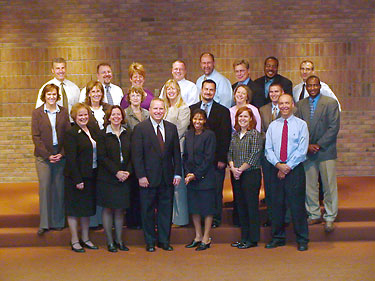The impending shortage of experienced leaders, combined with a higher turnover of younger talent and the need for new and critical leadership skills, led to creation of the Business & Finance Leadership Academy.
The academy two weeks ago graduated its first class and last week presented recommendations from the Action Learning Project Teams to B&F leadership.

“Our goal is simply this: to prepare the next generation of the most talented business and finance administrative leaders with the strategic skills necessary to support the University of Michigan in maintaining its competitive position now and in the future,” says Catherine Lilly, head of the B&F Leadership Academy program, and senior adviser to the executive vice president and chief financial officer. “Specifically, we are focused on developing the B&F leadership competencies our senior staff have prioritized, and measuring this development through ongoing 360-degree competency assessments and demonstrated use of the skills in their current functions.”
Based on a study conducted three years ago, in the next five years more than 60 percent of Business & Finance managers and supervisors at all levels in the organization will be eligible to retire, Lilly says.
“Though they will not necessarily all retire at that point, during the next 10 years we will be facing unprecedented challenges in filling open leadership positions with experienced internal candidates,” says Laura Patterson, chief information officer and associate vice president for Information and Technology Services. “Of course, we also welcome talent from the external labor market. However, higher education in general will be facing this challenge, making the external market for talented administrative higher education leadership highly competitive.”
Other research indicates that after about five years of tenure with the university, employees are less satisfied than in other periods, producing higher turnover, Lilly says. “Thus, we are also at risk of losing those talented younger or early-tenure managers who don’t see immediate promotional opportunities or any kind of commitment to their future with us.”
The academy addresses these concerns by taking advantage of expertise already on campus. Faculty members, CFO senior staff, the provost and U-M vice presidents talk with participants about what leaders will experience in 10 years, she says. The business and finance senior staff also assign projects to the class members to contribute to the effectiveness of the business and finance organization and utilize leadership concepts learned in the class.
B&F senior staff members select 24 nominees to take part in the 10-month program, and have just completed the orientation for the 2010 class. The leadership academy actually is a three-year program. While the first year focuses on a competency-based curriculum, it transitions into a two-year alumni program with support, peer-coaching and professional development.
“Of all of the leadership programs I have led, this leadership development program is by far the most developmentally comprehensive, aligned with senior leadership and organizational goals, and strategically focused on our future,” Lilly says.
“In higher education we are in a highly competitive business, especially for talented faculty, staff and students,” says Tim Slottow, executive vice president and chief financial officer. “Investing in the development of future administrative leaders who can most effectively Make Blue Go (the B&F mission) — that is, support the university’s mission and its quality — is a strategic commitment we are willing to make.”

